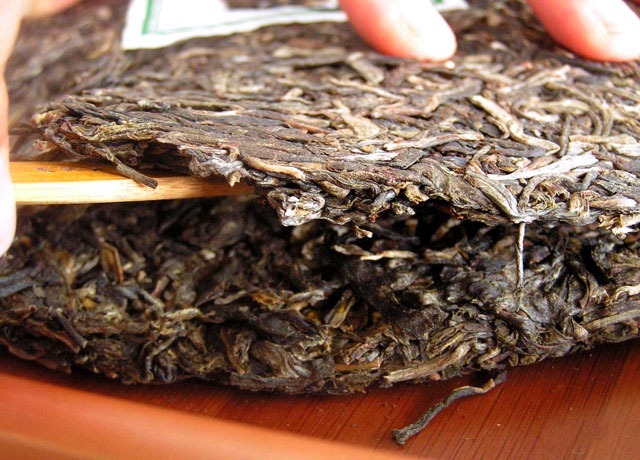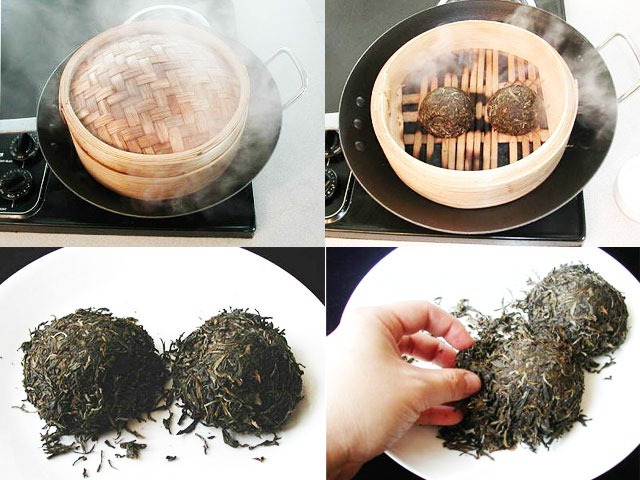
Seperating the Pu-erh Tea Cake
Preparation of pu-erh involves first separating a well-sized portion of the compressed tea for brewing. This can be done by flaking off pieces of the cake or by steaming the entire cake until it is soft from heat and hydration. A pu-erh knife, which is similar to an oyster knife or a rigid letter opener, is used to pry large horizontal flakes of tea off the cake such as to minimize leaf breakage.

Steaming Pu-erh Tuo Cha
Steaming is usually performed on smaller teas such as tuocha or mushroom pu-erh and involves steaming the cake until it can be rubbed apart and then dried. In both cases, a vertical sampling of the cake should be obtained since the quality of the leaves in a cake usually varies between the surface and the center of the cake.

Gong Fu Pu-erh
Pu-erh is generally expected to be served Gong Fu style, generally in Yixing teaware or in a type of Chinese tea cup called a gaiwan.
Optimum temperatures are generally regarded to be around 95 degree Celsius for lower quality pu-erhs and 85-89 degree Celsius for good ripened and aged raw pu-erh. Steeping times last from 12–30 seconds in the first few infusions, up to 2–10 minutes in the last infusions.
The prolonged steeping techniques used by some western tea makers can produce dark, bitter, and unpleasant brews. Quality aged pu-erh can yield many more infusions, with different flavour nuances when brewed in the traditional Gong-Fu method.
Because of the prolonged fermentation in ripened pu-erh and slow oxidization of aged raw pu-erh, these teas often lack the bitter, astringent properties of other tea types, and also can be brewed much stronger and repeatedly, with some claiming 20 or more infusions of tea from one pot of leaves.
On the other hand, young raw pu-erh is known and expected to be strong and aromatic, yet very bitter and somewhat astringent when brewed, since these characteristics are believed to produce better aged raw pu-erh.


Hey there! Someone in my Myspace group shared
this website with us so I came to give it a look.
I'm definitely enjoying the information. I'm book-marking
and will be tweeting this to my followers! Fantastic blog and great design and
style.
Thanks for sharing your thoughts about index. Regards
Maximizing Efficiency: Advanced Strategies for Your CNC Workbench!
Introduction
What will you want to do? Take up higher-than-average strategies for CNC Workbench where innovation and efficiency
meet. Find high tech features like quick changeovers and
flexible scheduling as well as the knowledge gain, education and
training you need. Carefully put together in every detail and the
machine runs on its own to achieve top level of operational excellence; this is why our CNC workbench is the
highest standard of production in the industry.
Optimizing Your CNC Workbench Layout!
• Importance of an ergonomic and logical layout
Ergonomic Design
Craftsmen prioritize ergonomic design for CNC workbenches, reducing fatigue.
Adjustable heights and angled surfaces enhance user comfort.
Key tools within arms reach streamline tasks. Proper lighting minimizes strain.
Logical Arrangement
Logical placement of tools on a CNC workbench boosts efficiency.
Group related items for seamless access. Position frequently used tools at the forefront.
Label compartments for easy identification, ensuring smooth operation.
Space Utilization
Maximizing space on a CNC workbench is crucial.
Utilize CNC vertical machining holders for drills and bits.
Sliding drawers organize smaller components. Overhead shelves free up valuable work surface.
Efficient design accommodates more projects.
Accessibility Focus
Accessibility is key in a CNC workbench setup. Ensure
clear pathways for easy movement. Keep emergency stops visible and reachable.
Designate zones for different activities, enhancing safety.
User-friendly interfaces on machines aid in operation.
Workflow Integration
Integrating workflow into CNC workbench design enhances
productivity. Layout reflects the manufacturing process.
Material intake and product output areas are distinct. Centralized
control panels streamline machine use. Organized tools reduce downtime,
boosting output.
• Tips for arranging tools and materials for easy access and workflow enhancement
Vertical Storage
Maximize CNC Workbench efficiency with smart vertical storage solutions.
Racks and shelves hold materials, tools within reach.
Organize items by frequency of use, top for rare, bottom for common. Benefits include saved space, quick access.
Ideal for small and large workspaces alike is enhancing productivity significantly.
Labeled Bins
CNC Workbench organization excels with labeled bins.
Store bits, cutters, and jigs systematically. Each bin, tagged with contents,
streamlines finding parts. Reduces downtime is searching for components.
A mix of sizes accommodates diverse items.
Essential for maintaining a clutter-free environment is ensuring a
smooth workflow.
Shadow Boards
Implement shadow boards at the CNC Workbench. Outline tools on boards for easy identification, return. Visual management tool prevents loss, misplacement.
Custom shapes signal correct storage spot for each tool.
Boosts efficiency, supports 5S methodology. This is Ideal for quick tool retrieval, maintaining order.
Tool Holders
Optimize CNC Workbench with structured tool
holders. Designate spots for drills, end mills, collets.
Ensures tools are always at hand, organized.
Magnetic, pegboard holders offer flexibility, customization. This is
crucial for streamlined operations, quick changeovers.
Tool holders transform workbench into a highly efficient station.
Tool Management Strategies!
• Best practices for organizing and maintaining CNC tools
Regular Inspections
For CNC Workbench, conduct inspections often. Check tools for wear,
alignment issues. Identify problems early, prevent machine downtime.
A routine, detailed examination ensures tools perform at peak.
This is key for high-quality output, maintaining
high precision manufacturing in projects. Essential step
in tool management prolongs tool life.
Cleanliness Protocol
Maintain a clean CNC Workbench always. Dust, debris affects
tool performance, precision. Implement daily cleaning schedules.
Use appropriate cleaners for metal, electronic parts. A tidy workspace prevents accidents, ensures tools' longevity.
Cleanliness enhances operational efficiency, keeps the
workbench in optimal condition.
Sharpness Checks
Sharp tools are crucial at the CNC Workbench. Regularly
test for dullness, wear. Dull tools result in poor cuts, increased waste.
Use precision instruments to gauge sharpness. Immediate sharpening or replacement ensures consistent quality.
Sharpness checks are fundamental for efficiency, reducing material waste.
Inventory Control
Effective inventory control is key for CNC Workbench operations.
Catalog tools accessories with precise counts. Implement check-out, return procedures.
Regular audits prevent shortages, overstocking. This strategy optimizes tool usage,
saves costs. Inventory control keeps projects on schedule, ensures tool availability.
Digital Tracking
Incorporate digital tracking for CNC Workbench tools.
Use software to monitor tool location, usage, maintenance schedules.
Real-time data aids in decision-making, prevents loss.
Digital tracking simplifies inventory management, enhances operational workflow.
• Implementing tool tracking systems to minimize downtime
RFID Tags
For CNC Workbench efficiency, RFID tags are key.
They attach to tools, allowing quick scans. This system updates tool status instantly, reducing search times.
Perfect for fast-paced environments, it keeps tool
tracking simple. Ensures tools are always ready, minimizing operational delays.
Essential for maintaining continuous workflow, RFID tags are a game-changer.
Barcode Scanning
Barcode scanning at the CNC Workbench simplifies tool management.
Tools tagged with barcodes offer easy tracking.
Scan to check tools in or out, streamlining inventory.
This approach enhances tool security, prevents loss. It’s
a practical solution for busy workshops; ensuring tools are always accounted for.
Quick, efficient, barcode scanning is indispensable.
Digital Logs
Digital logs are critical for managing CNC Workbench tools.
They record usage, maintenance, and location, offering a clear history.
This data helps plan for tool needs, ensuring readiness. Access from any device makes information retrieval effortless.
It’s an effective strategy to avoid tool misuse and prolong their life.
Digital logs are a must-have for precision management.
Maintenance Alerts
Maintenance alerts for CNC Workbench tools are proactive. They signal when servicing is due,
keeping tools in top shape. This system prevents unexpected downtimes, ensuring reliability.
Tailor alerts to specific tool usage patterns for best results.
It’s crucial for smooth operations; making maintenance alerts a wise
investment.
Tool Lifecycle Management
Tool lifecycle management is vital at the CNC Workbench.
It tracks tools from purchase to retirement, assessing performance.
This insight aids in timely replacement decisions, optimizing investments.
Effective lifecycle management reduces waste, focuses on quality tools.
It’s key for operational excellence, ensuring every tool performs optimally.
Enhancing CNC Machine Performance!
• Regular Calibration
Calibrating CNC machines regularly is crucial for optimal performance.
Schedule checks on spindles, axes for accuracy. Calibration ensures precision in cuts, extends machine life.
Use calibrated instruments, follow manufacturer guidelines.
Regular calibration at the CNC Workbench reduces errors, boosts efficiency.
It's a non-negotiable practice for quality outcomes.
• Lubrication Schedule
A strict lubrication schedule for CNC machines prevents wear, tear.
Lubricate moving parts per OEM recommendations.
Use quality oils, greases for longevity. Proper lubrication maintains smooth operation, prevents overheating.
At the CNC Workbench, timely lubrication is key to machine health.
It saves on costly repairs, downtime.
• Upgrade Kits
Upgrade kits can significantly enhance CNC machine capabilities.
They include software updates, enhanced tooling options.
Installing the latest kits improves efficiency, accuracy.
Upgrades can extend machinery lifespan, add new features.
For any CNC Workbench, staying updated with technology is vital.
It ensures competitive edge, operational excellence.
• Speed Optimization
Optimizing speed settings on CNC machines maximizes productivity.
Adjust feed rates, spindle speeds for material, tooling.
Speed optimization reduces cycle times, improves finish quality.
Analyze performance data, adjust for optimal settings.
At the CNC Workbench, speed optimization is crucial for meeting production targets, maintaining high standards.
• Precision Testing
Precision testing is essential for maintaining CNC machining accuracy.
Implement regular testing routines using precise measuring tools.
Test cuts, dimensional checks ensure adherence to specifications.
Precision testing at the CNC Workbench identifies calibration needs, prevents quality issues.
It's fundamental for delivering consistent, high-quality products.
Feature Regular Calibration Lubrication Schedule Upgrade Kits Speed Optimization Precision Testing
Objective Ensure accuracy & precision Minimize wear & tear Enhance capabilities Improve efficiency Validate machining accuracy
Frequency Quarterly/As needed Daily/Weekly As upgrades are released Continuous monitoring Pre & Post-operation
Tools/Equipment Calipers, Micrometers Lubricants, Grease guns Software, Hardware kits CNC Controller settings Gauges, CMMs
Impact on Performance High precision & quality Extended machine life New functionalities Reduced
cycle times Error minimization
Skill Level Required High Moderate High High High
Cost Moderate to High Low to Moderate High Moderate Moderate to High
ROI High High Variable High High
Table on Enhancing CNC Machine Performance!
Material Handling and Preparation!
• Pre-Cutting Checks
Prioritize pre-cutting checks at the CNC Workbench for flawless operations.
Inspect materials for defects, dimensions accuracy before
machining. Confirm tool sharpness, alignment for precision. These steps prevent waste, ensure product quality.
Essential for maintaining standards, pre-cutting checks are the first line of defense against errors.
• Material Labeling
Material labeling at the CNC Workbench streamlines workflow.
Assign labels detailing type, thickness, and intended use.
This practice avoids confusion, enhances efficiency. Labels
act as quick references, speeding up material selection. For any
project, organized labeling is key to managing resources effectively, ensuring the right material is always used.
• Moisture Control
Moisture control is critical in CNC Workbench environments.
Store materials in dry conditions are prevent warping, swelling.
Use dehumidifiers in humid climates to protect integrity.
Moisture-compromised materials affect precision, waste resources.
Proactive moisture control is a must for quality outcomes, equipment longevity.
• Flatness Assurance
Ensure material flatness before CNC machining for optimal results.
Use precision levels, surface plates for verification. Flat materials eliminate rework, enhance detail accuracy.
Critical for intricate designs, flatness assurance is foundational to
achieving desired finishes. It guarantees efficiency,
reduces material strain at the CNC Workbench.
• Stock Organization
Effective stock organization boosts productivity at
the CNC Workbench. Implement shelving, categorization systems for order.
This approach minimizes search time, expedites selection. An organized
stock area supports seamless operations, allowing quick transitions between tasks.
Workflow Automation on the CNC Workbench!
• Software Integration
Integrating advanced software with the CNC Workbench streamlines operations.
It enables precise control over machining processes,
enhancing efficiency. Software such as CAD/CAM transforms designs into executable paths,
reducing manual input. Essential for high-volume production, it minimizes errors, ensures consistency.
Key to modern machining, software integration is a cornerstone of automation.
• Pallet Systems
Pallet systems revolutionize material handling at the CNC Workbench.
They facilitate quick setup changes, maximizing machine uptime.
Automated pallet changes reduce manual labor, speed up production cycles.
Ideal for high-mix, low-volume jobs, they keep machines running efficiently.
Implementing pallet systems is a strategic move towards lean manufacturing.
• Automated Loading
Automated loading mechanisms enhance productivity at the CNC Workbench.
Robots or conveyors supply materials, ensuring continuous operation. This automation reduces human intervention,
lowers the risk of injuries. It guarantees a steady supply of
workpieces, optimizing machine use. Crucial for long runs, automated loading is a
key efficiency driver.
• Program Sequencing
Program sequencing software optimizes the CNC Workbench workflow.
It schedules tasks for minimal tool changes, reducing idle time.
Advanced algorithms predict efficient sequences, saving
valuable machining time. This approach is vital for complex parts, ensuring timely completion. For peak performance, program sequencing is indispensable.
• Tool Path Optimization
Tool path optimization software is critical for enhancing CNC Workbench
efficiency. It calculates the most efficient routes, reducing machining time, tool wear.
Optimized paths ensure smoother finishes, extend tool life.
Key for complex geometries, it significantly reduces cycle
times. Tool path optimization is fundamental for quality and speed.
Operator Training and Skill Development!
• Continuous Learning
Continuous learning is pivotal for CNC Workbench operators.
It ensures skills remain sharp in evolving manufacturing
landscapes. Workshops and webinars offer new techniques, tooling insights.
Embracing a culture of learning fosters innovation, keeps teams
ahead of medical industry curves.
• Skill Certification
Skill certification elevates CNC Workbench operations.
It validates expertise in machining, programming, and maintenance.
Certification programs from recognized institutions set benchmarks for quality, safety.
Operators with certifications bring verified skills, enhancing team capabilities.
Pursuing these credentials supports career progression, workplace efficiency.
It's a commitment to professional development, operational excellence.
• Safety Training
Safety training is non-negotiable at the CNC Workbench.
Comprehensive programs cover emergency procedures, equipment handling,
and hazard recognition. Regular drills reinforce safety protocols, ensuring
readiness. A safe workplace minimizes accidents, boosts morale.
Investing in ongoing safety training is essential for protecting operators, maintaining high productivity standards.
• Software Proficiency
Software proficiency is critical for maximizing CNC Workbench potential.
Mastery over CAD/CAM systems enables complex designs, efficient toolpaths.
Training sessions update operators on latest software
enhancements, integration features. High software proficiency
translates to reduced setup times, error margins.
It’s key for streamlined operations, delivering precision on complex projects.
Advanced Setup Techniques!
• Fixture Innovations
At the CNC Workbench, fixture innovations are transforming setup
efficiency. Customizable clamps and modular fixtures reduce setup times, enhance precision. These advancements support
versatile machining processes, accommodate complex parts.
Implementing innovative fixture solutions is crucial for competitive manufacturing,
ensuring quick adaptation to varied production demands.
• Rapid Changeovers
Rapid changeover techniques at the CNC Workbench are pivotal for minimizing
downtime. Utilizing quick-release mechanisms and preset tooling accelerates transitions
between jobs. This strategy optimizes milling
machine utilization, boosts output. Emphasizing speed and
efficiency, rapid changeovers are essential for meeting tight production schedules in dynamic manufacturing environments.
• Tolerance Strategies
Implementing precise tolerance strategies at the
CNC Workbench ensures high-quality production. Advanced measuring tools and software monitor machining accuracy,
facilitating adjustments in real-time. This proactive approach to tolerance management minimizes
rework, maintains product consistency. It’s fundamental
for achieving excellence in precision manufacturing, satisfying
stringent quality standards.
• Adaptive Programming
Adaptive programming technology revolutionizes operations at the CNC Workbench.
It dynamically adjusts cutting conditions based on real-time
feedback, optimizing tool paths. This approach reduces tool wear, improves
surface finish. Adopting adaptive programming enhances machining efficiency, adapts to material variances.
It's a smart strategy for modern, data-driven manufacturing.
Conclusion
Utilizing proven CNC machining features and greater than ever advancements, provides you with opportunities
to excel in modern machining. And, this is achieved through an employee commitment to seeking constant improvements of the products and technologies combined, which is more than just a dream but a reality in the company.
This trip is a stepping stone for other journeys
in the future, and you can visit CNCYANGSEN to discover more.
Avoid the quandary of CNC Workbench, and choose the
path of success where only the best can harbor the ultimate achievement.
Why users still make use of to read news papers when in this technological world
everything is available on net?
Nice weblog here! Additionally your site
quite a bit up very fast! What web host are you the usage of?
Can I get your affiliate hyperlink in your host?
I desire my site loaded up as fast as yours lol
I am really enjoying the theme/design of your weblog.
Do you ever run into any browser compatibility issues?
A couple of my blog visitors have complained about
my site not operating correctly in Explorer but looks great in Opera.
Do you have any tips to help fix this issue?
I was suggested this web site by my cousin. I am not sure whether this post is written by him as nobody else know such detailed about
my difficulty. You are amazing! Thanks!
Every weekend i used to pay a visit this site, because i wish
for enjoyment, for the reason that this this site conations genuinely pleasant funny information too.
buy viagra online
This blog was... how do I say it? Relevant!! Finally
I've found something that helped me. Many thanks!